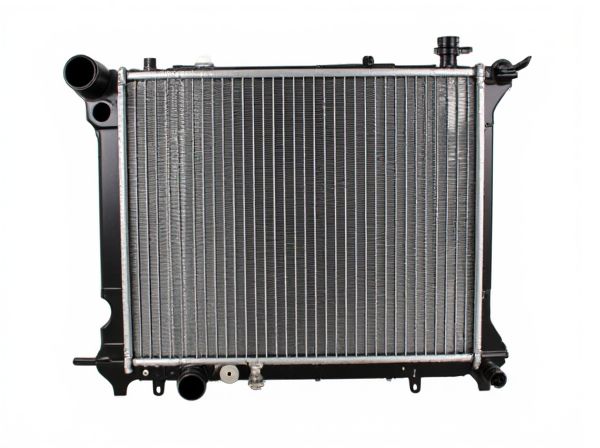
Photo illustration: Tube-Fin vs Plate-Fin Radiator
Tube-fin radiators offer superior durability and easier maintenance due to their robust construction, making them ideal for heavy-duty applications. Plate-fin radiators excel in compactness and high heat transfer efficiency, optimized for confined spaces where maximizing surface area is crucial. Your choice depends on balancing airflow requirements, cooling performance, and installation constraints.
Table of Comparison
| Feature | Tube-Fin Radiator | Plate-Fin Radiator |
|---|---|---|
| Core Structure | Round tubes with attached fins | Flat plates with fins pressed between |
| Heat Transfer Efficiency | Moderate, suitable for standard cooling | High, optimized for rapid heat dissipation |
| Weight | Heavier due to tubular design | Lighter with compact plate construction |
| Durability | Robust, better resistance to impact | Sensitive to vibration, may require careful mounting |
| Manufacturing Cost | Lower, traditional manufacturing process | Higher due to complex assembly |
| Maintenance | Easier to clean and repair | More complex, restricted access to fins |
| Application | Standard vehicles, everyday use | High-performance vehicles, heavy-duty cooling |
Introduction to Radiator Technologies
Tube-fin and plate-fin radiators represent two primary heat exchanger technologies widely used in automotive and industrial cooling systems. Tube-fin radiators consist of tubes carrying fluid with fins attached externally to enhance heat dissipation, offering robust performance in high-pressure applications. Plate-fin radiators utilize a series of thin metal plates and fins that promote superior heat transfer efficiency and compact design, making them ideal for space-constrained environments and high thermal loads.
Overview of Tube-Fin Radiators
Tube-fin radiators utilize a series of parallel tubes with fins attached to increase surface area, enhancing heat dissipation efficiency. They are commonly constructed from lightweight aluminum or copper, offering superior thermal conductivity essential in automotive and HVAC applications. This design supports high airflow rates and effective cooling performance, making tube-fin radiators advantageous for demanding thermal management needs.
Overview of Plate-Fin Radiators
Plate-fin radiators utilize thin metal fins stacked and bonded to enhance heat dissipation by increasing surface area and promoting efficient airflow. Their compact design allows for higher heat transfer rates in limited spaces, making them ideal for applications in aerospace, automotive, and electronics cooling. The aluminum construction combined with intricate fin patterns improves thermal conductivity and reduces weight compared to tube-fin radiators.
Key Design Differences
Tube-fin radiators use cylindrical tubes to channel coolant, surrounded by fins that increase surface area for heat dissipation, making them effective for moderate to high-pressure systems. Plate-fin radiators consist of flat plates with closely spaced fins, providing a compact design with high heat transfer efficiency due to larger fin surface area and better airflow management. Key design differences include material usage, with tube-fin often employing copper or aluminum tubes, while plate-fin designs utilize aluminum plates, influencing weight, thermal performance, and manufacturing complexity.
Heat Transfer Efficiency Comparison
Tube-fin radiators offer enhanced heat transfer efficiency due to their larger surface area and improved airflow distribution, enabling effective dissipation of high thermal loads. Plate-fin radiators feature compact fin designs that provide increased turbulence, boosting convective heat transfer rates in confined spaces with limited airflow. Selecting between tube-fin and plate-fin radiators depends on application-specific requirements such as space constraints, cooling capacity, and fluid dynamics for optimal thermal performance.
Durability and Longevity
Tube-fin radiators exhibit superior durability due to their robust construction, typically involving thicker tubes and welded joints that resist corrosion and mechanical stress over time. Plate-fin radiators offer high efficiency but tend to be more susceptible to damage from vibration and thermal cycling, which can reduce their lifespan in harsh environments. Selecting tube-fin radiators ensures extended longevity in industrial applications requiring consistent performance and minimal maintenance.
Weight and Size Considerations
Tube-fin radiators generally weigh more and occupy larger volumes due to their cylindrical tubes and thicker fin structures, making them less suitable for applications with strict weight and size constraints. Plate-fin radiators offer a compact and lightweight design by utilizing flat plate-like fins, optimizing heat transfer surface area while minimizing overall dimensions. Selecting between the two depends on the balance needed between thermal performance, weight, and spatial limitations in specific engineering applications.
Cost and Manufacturing Aspects
Tube-fin radiators generally incur higher manufacturing costs due to their complex assembly involving tubes and fins welded or brazed together, demanding more labor and precise equipment. Plate-fin radiators benefit from streamlined, cost-effective manufacturing processes utilizing flat sheets of metal created through stamping or rolling, resulting in lower production expenses and faster turnaround. Cost efficiency in plate-fin designs often makes them preferable for high-volume applications, while tube-fin configurations provide durability that can justify their premium price in specialized industries.
Application Suitability: Automotive and Industrial
Tube-fin radiators excel in automotive applications due to their robust construction and efficient heat dissipation in compact spaces, making them ideal for engine cooling systems. Plate-fin radiators are better suited for industrial settings where high thermal performance with low weight and volume is critical, such as in HVAC systems and power plants. The selection depends on factors like operating temperature, fluid type, and space constraints, with tube-fin favored for durability and plate-fin for enhanced heat transfer efficiency.
Conclusion: Choosing the Right Radiator Type
Tube-fin radiators offer superior durability and ease of maintenance, making them ideal for heavy-duty industrial applications requiring high reliability. Plate-fin radiators provide greater heat transfer efficiency and compact design, suitable for aerospace and high-performance automotive cooling systems. Selecting the right radiator type depends on balancing factors such as thermal performance, space constraints, operating environment, and maintenance needs.
 caratoz.com
caratoz.com